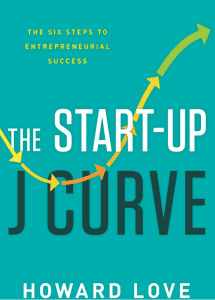Embracing the Start-Up J Curve

The Start-Up J Curve: The Six Steps to Entrepreneurial Success places the six phases on the classic entrepreneurial J-curve, so named for the inevitable early-stage challenges most start-ups take. Love dispels the “straight line to success” myth that pervades the industry, helping entrepreneurs comprehend why each phase occurs, and what they should focus on during each phase.
Embracing the J-Curve
Love provides excellent insights from his years as the founder or co-founder of seven companies and as an angel investor in a number of others.
Let’s take a closer look at the six stages, the first three or four of which need to be navigated before most companies come close to turning a profit:
- Create. The Create stage is where the “big idea” is formed. Love encourages entrepreneurs to be “problem-sensitive” during this phase. This means looking closely at the world and pinpointing specific, solvable problems. Identified problems lead to solutions that can be commoditized and spun into profitable start-ups.
- Release. Too often, Love argues, entrepreneurs focus on perfection and tinkering, wanting to get things just right, add one more feature, or go through one more round of updates. Love encourages entrepreneurs not to get trapped in this phase. “Too much tinkering in the context of a startup can be an unconscious delaying,” Love writes. Tinker too much, and a would-be entrepreneur may never be able to pull the trigger. Love encourages start-up founders to be OK with getting products, even seemingly imperfect ones, to the market.
- Morph. This phase is all about customer traction, according to Love. It also is one of the most challenging. It requires entrepreneurs to make changes based on how customers are using, or not using, a product. Entrepreneurs have to focus on what is most compelling to customers. Morphing the product to meet consumer needs is essential, although at times, it may be painful as entrepreneurs let go of parts of their original vision. However, Love stresses that morphing is not about failure; it’s about refining a product to meet customer interest.
- Model. At this stage, Love believes an entrepreneur should focus on how to rethink the business plan. While a preliminary, strategic business plan is prudent at earlier phases, during the Model phase it is wise to reexamine assumptions and business models, particularly if the Morph phase radically changed the product or market focus.
- Scale. Scaling is a very relative phase, depending on the product or service. For some companies, the Scale phase may mean a ten-fold increase in operations. For others, it may mean becoming 100 times bigger. However, it’s important that you scale not only when you have the money to do so, but when your business plan is robust and reflects the expansion.
- Harvest. Love argues that the Harvest phase is, in many ways, the most fun. This is when an entrepreneur can reap the rewards of all the hard work. Entrepreneurs can be deceived by the hyper-growth that precedes a Harvest phase, but such growth will not last forever. Knowing when the time is right to cash out by taking the company public or selling it is important.
Addressing failure
Each chapter of the book includes examples and stories, many from Love’s own entrepreneurial experiences. Throughout the book, he encourages start-up founders to take each mistake or setback as a learning opportunity.
“Instead of feeling lost and confused when you suffer a setback – something that happens to start-ups quite frequently in their initial stages – you’ll be able to put these problems in context,” Love writes. “By knowing exactly where you are on the path, and what to do at that point in time, your odds of success will increase, and you will get to success faster.”
